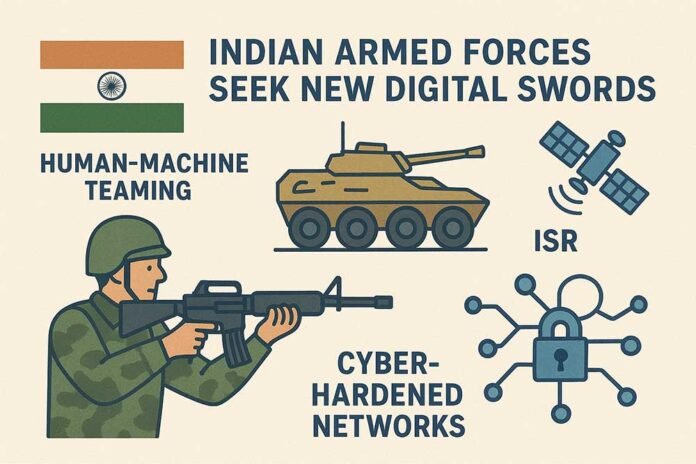New Delhi: In keeping with the latest technology in next-gen combat vehicle with UAV, loitering weapons will replace Army’s T-72s. The army’s Future Ready Combat Vehicle (FRCV) will integrate human-machine teaming, ISR systems, and cyber-hardened networks to operate in a fully digitised battlefield.
The armed forces are seeking new ‘digital swords’ to counter emerging threats, including indigenous tools to detect deep fakes, cyber ranges to train soldiers in offensive and defensive tactics, and man-portable electronic warfare suites. While several tools are available in the global market, the armed forces require indigenous solutions to deal with sensitive information and customisation. On the list of technologies it requires in the near future a Deep Fake detection software that can achieve 100% accuracy in almost real time. In the wake of the Pahalgam attack, the armed forces came under a severe cyber and information warfare attack in the run-up to Operation Sindoor with actors originating from Pakistan putting out thousands of images and videos, besides attempting to infiltrate secure networks.
“Even when a software is developed, it needs to be ensured that it is future ready since with regular advancement in technology, newer ways to create deep fakes are being developed,” the Army’s requirement spelt out in the technology perspective and capability roadmap reads.
The forces also require to set up Cyber Ranges to train its warriors on defensive and offensive operations. The requirement is for 20 licence keys, each capable of supporting 200 subscribers concurrently, to train cyber teams. The cloud-based range is needed to train several types of attacks and defence including on mail servers and voice over internet protocol. Cyber defences are required in space as well, with the forces spelling out the requirement for satellites with onboard cyber defence suites, quantum-encrypted downlinks and AI-powered mission planning.
For secure communication, the forces require thousands of software defined radios that can share data across the battlefield. On the ground, the forces need Man-Portable Electronic Countermeasures kits to jam or spoof enemy drones, radio links and GPS signals.
Meanwhile, in keeping with the latest technology in modern warfare, a future-ready combat vehicle (FRCV) is set to replace the Indian Army’s Russian-origin T-72 main battle tanks, with an estimated 1,800 units — conceived as a “multiple weapon platform” — to be developed and inducted over the coming years. The 15-year defence modernisation plan announced last week envisions the FRCV operating in a highly network-centric environment along the northern and western borders. The two border areas are indeed under constant threat from two fronts and to keep the troops ever alert, the latest weapon technology is kept in readiness to ensure that these threats are tackled without any problems.
The Technology Perspective and Capability Roadmap (TPCR), which provides the defence industry with an insight into the Armed Forces’ capability requirements for the next 15 years, has highlighted the need for an FRCV expected to serve in the Army for at least 40 years after induction. Drawing on lessons from the Russia-Ukraine war — where autonomous systems have inflicted lethal damage on massed armoured forces — a key feature of the planned combat vehicle will be its ability to control a range of unmanned systems.
The FRCV will incorporate human-machine teaming and integrated intelligence, surveillance, and reconnaissance (ISR) capabilities — critical for survival on the modern battlefield, where the kill chain — or the process of identifying, targeting, engaging, and destroying a threat — has been compressed from around half an hour to barely three minutes. These capabilities will be enabled by a “fully digitised system” designed to support human-machine collaboration and the control of on-board or off-board unmanned systems, including unmanned ground and aerial vehicles as well as loitering munitions. Operating surveillance drones and loitering munitions as a unified system from the FRCV will further allow strikes beyond line of sight.
To function in a network-centric environment, the planned platform will also feature an integrated battlefield management system and Identification Friend or Foe (IFF) capability. These will give soldiers operating the vehicles a shared operational picture, accessible across the services, and support collaborative, all-weather operations. For instance, if an Air Force platform detects an adversary force, Army elements will simultaneously gain real-time access to that information.
The FRCV will also carry day-and-night sensors mounted on its hull and turret, offering a 360-degree panoramic view of the surrounding environment. These inputs will feed into the forces’ broader Command, Control, Communications, Computers, and Intelligence (C4I) system. The future vehicle is also envisioned to be fully hardened against cyberattacks and capable of operating in a contested electronic warfare environment. It will be designed to counter adversary jamming, ensuring unrestricted and secure voice and data communication, as well as reliable control of drones. In an increasingly global positioning system (GPS)-denied battlefield, this capability will be vital.
The recent brief battle against Pakistan in the wake of Pahalgam attack showed how effectively Indian armed forces successfully dealt with the threat from across the border and ensured that least damage was caused to Indian armed forces. In the wake of the Pahalgam attack, the Indian armed forces gave a fitting reply to the Pakistani armed forces and destroyed the terrorist camps in Pakistan using indigenously made drones that effectively neutralised the Pakistani attacks and inflicted immense damage.
The FRCV’s requirements appear aligned with — and intended to advance — the army’s reorganisation into new frontline formations — the ‘Rudra’ all-arms brigades, ‘Bhairav’ light commando battalions, and ‘Shaktibaan’ artillery regiments. These recently announced elements represent the latest stage in a two-decade effort to reshape land warfare, aimed at reducing the interval between political decision-making and military action, while also addressing the lessons from Operation Sindoor and doctrinal changes by China’s People’s Liberation Army. Together with the air force and navy, the army is working to align force structure, technology, logistics, command and control, and doctrine to create an agile force capable of operating across the spectrum of next-generation warfare.
– The writer is a senior journalist and media consultant. The views expressed are of the writer and do not necessarily reflect the views of Raksha Anirveda.






